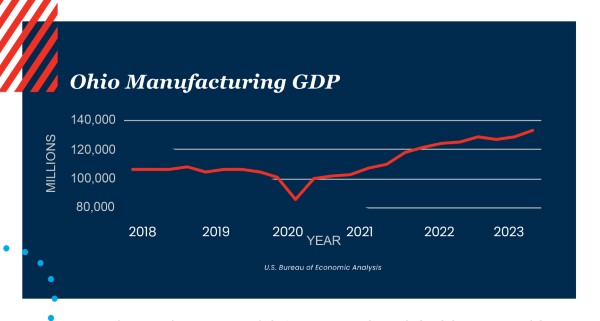When it comes to the art of making things, few states can match Ohio. As reported last winter by the U.S. Bureau of Economic Analysis, Ohio’s manufacturing GDP was $133.16 billion — fourth in the nation — high cotton for a state not named either Texas or California. According to the Ohio Manufacturers’ Association (OMA), manufacturing is the largest of the state’s economic sectors, representing 15.7% of Ohio’s total output.
Ask those in the know for Ohio’s secret sauce and they’re likely to identify its workers as ingredient number one. According to the U.S. Bureau of Labor Statistics, Ohio’s manufacturing workforce numbers 689,900, third in the nation behind only the much larger and aforementioned California and Texas. Ohio, however, brings more than just numbers to the table.
“There’s no one that can hold a torch to Ohio manufacturing workers,” says Ryan Augsburger, OMA’s president. Augsburger points to studies that favorably compare Ohio workers to their vaunted counterparts in Germany and Japan.
“They are,” says Augsburger, “among the most dedicated, productive manufacturing employees in the world.”

It’s a refrain that’s voiced often: Manufacturing is part of Ohio’s DNA.
“Ohioans wear that as a badge of honor,” says Lydia Mihalik, director of the Ohio Department of Development. “We’re hard-nosed, we’re tough, and it’s been like that for generations. America knows it and the world knows it,” Mihalik says. “It’s why Intel set up shop here.”
Indeed, Intel cited Ohio’s “robust workforce” as one of the top reasons for choosing the Columbus region for the largest economic development project in state history. Intel’s $20 billion semiconductor facility is to employ 3,000 people when it launches in 2025. The average projected salary of $135,000 reflects the skill levels those jobs will require. Not coincidentally, Ohio’s 27 colleges and universities graduate close to 12,000 engineers and engineer techs each year.
Leading with Innovation
Intel isn’t alone among cutting-edge manufacturers banking significant chunks of their futures on Ohio. Honda, Ford and GM all have chosen Ohio for investments intended to drive the generational shift to electric vehicles. Joby Aviation, which aims to create a fleet of air taxis, selected Dayton to build a nearly half-billion-dollar facility to produce its all-electric, vertical takeoff and landing craft. GE Aerospace makes turboprop and turboshaft engines in Cincinnati, where it employs a robust force of more than 6,000 workers. Whirlpool churns out top-of-the-line dishwashers by the tens of thousands at massive plants in Findlay and Clyde.
In another notable sign of the Buckeye State’s momentum in luring the industries of the future, Amazon committed in 2023 to investing $7.8 billion by the end of 2029 to expand its data center operations in Central Ohio, creating hundreds of new jobs. The expansion lends ballast to Ohio’s emerging position as the hub of the “Silicon Heartland,” and holds the potential to supercharge economic growth by solidifying the state’s technological infrastructure.
“Amazon’s continued growth here further cements Ohio as the heart of our nation’s technology and innovation,” said Gov. Mike DeWine. The investment, says DeWine, “will help new and existing businesses grow.”
Legacy industries are expanding in Ohio, as well. In February, BASF announced an investment of $70 million in its Cincinnati chemicals plant. In Toledo, with its deep roots in glass manufacturing, Nippon Sheet Glass is expanding its Flat Glass capacity, investing $160 million. In the village of Mingo Junction in the mining region of Eastern Ohio, JSW Steel USA is upgrading operations to the tune of $120 million and creating 26 new jobs.
“These new investments,” said JSW Director Parth Jindal, “reiterate JSW’s commitment to a sustainable and green future.”

Competitive Advantages
The JSW expansion is supported by JobsOhio, the unique private non-profit established by the state in 2011 to help drive job creation and business investment by identifying and targeting high-growth industries. Generously funded by profits from the state’s beverage industry, JobsOhio has contributed to creating or retaining more than a million jobs while helping to guide the transformation of the state’s manufacturing industries.
“When it comes to economic development,” says Mihalik, “JobsOhio is a huge competitive advantage. They’re a nimble, private organization that really is the front door to our state. They’re professionals who do a wonderful job of touting the value proposition that Ohio has for the private sector.”
With so much economic change afoot, businesses making major investments increasingly covet locations that offer stability over surprises. This, too, plays to Ohio’s advantage.
“Ohio,” says OMA’s Augsburger, “has a strong competitive advantage in greater predictability around our legal environment. It’s much harder in Ohio than other states to get hit with a frivolous lawsuit. Our state environmental laws are extremely predictable and hyper competitive. We have the lowest worker’s compensation insurance costs in the country.”
Augsburger lauds the state government for trimming taxes on machinery and equipment, which offers manufacturers, another layer of predictability. It’s one of the many ways that Ohio is out to demonstrate that it’s open for business.
“We’ve lowered taxes,” says Mihalik. “We’re doing what we can to make sure that we have project-ready sites. We’re making sure that we address our workforce issues so that manufacturers have the talent that they need to continue to compete in a global economy. At the end of the day,” Mihalik declares, “the three most competitive words today in American manufacturing are ‘Made in Ohio.’ ”

